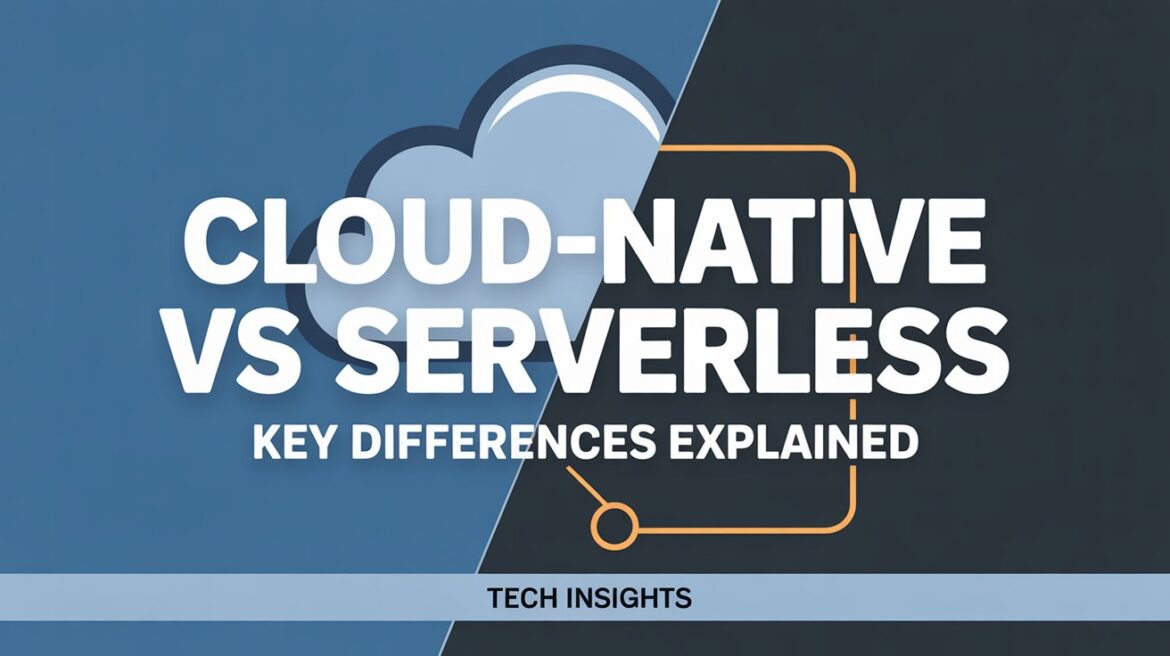As organizations modernize their software delivery pipelines, two paradigms dominate cloud-native development: cloud-native applications and serverless architectures. While both approaches leverage managed cloud services for scalability and agility, they differ in operational overhead, cost models, and design patterns. In this post, we’ll define each model, compare their core characteristics, outline benefits and drawbacks, and provide guidance on when to choose cloud-native versus serverless for your next project.
What Is Cloud-Native Development?
Cloud-native refers to building applications specifically designed to run on cloud platforms, taking full advantage of features like containerization, microservices, and orchestration. Key elements include:
- Containers: Encapsulate microservices with dependencies, ensuring consistency across environments (e.g., Docker).
- Orchestration Platforms: Tools like Kubernetes manage container lifecycle, scaling, self-healing, and service discovery.
- Infrastructure as Code (IaC): Declarative templates (Terraform, CloudFormation) provision compute, storage, and networking.
- DevOps Practices: Continuous integration/continuous deployment (CI/CD), automated testing, and monitoring baked into the delivery pipeline.
Cloud-native apps are composed of loosely coupled services that communicate via APIs or message queues. This decoupling enables independent feature development, deployment, and scaling.
What Is Serverless Development?
Serverless abstracts away server management entirely. Developers focus solely on writing code, while the cloud provider handles provisioning, scaling, and patching. Two dominant serverless models are:
- Function-as-a-Service (FaaS): Event-triggered functions (AWS Lambda, Azure Functions, Google Cloud Functions) execute in response to HTTP requests, message queue events, or other triggers.
- Backend-as-a-Service (BaaS): Managed services (database, authentication, storage) expose APIs so applications consume fully managed capabilities (e.g., Firebase, Auth0).
With serverless, you pay only for actual compute time (measured in milliseconds) and managed service usage, avoiding costs for idle resources.
Architecture & Operational Comparison
| Aspect | Cloud-Native | Serverless |
|---|---|---|
| Provisioning | Provision clusters, nodes, and services | No servers to provision |
| Scaling Model | Declarative autoscaling (K8s HPA, cluster autoscaler) | Automatic, per-function invocation |
| Operational Overhead | Moderate—manage orchestration, networking, logging | Low—cloud handles runtime & OS patching |
| Cold Starts | None or minimal (containers always warm) | Possible cold starts on first invocation |
| State Management | Stateful or stateless microservices; external state stores | Stateless functions; state in external services |
| Cost Model | Pay for provisioned VMs/containers | Pay per invocation and managed services |
| Deployment Time | Minutes for container rollout | Seconds for function deployment |
| Vendor Lock-In | Moderate—Kubernetes is portable | Higher—proprietary FaaS/BaaS APIs |
Benefits of Cloud-Native
- Portability & Flexibility
Containers and Kubernetes run on any major cloud or on-prem, reducing lock-in risk. - Fine-Grained Control
You configure networking, storage, and runtime parameters to optimize performance and security. - Mature Ecosystem
Rich tooling for logging (ELK), monitoring (Prometheus/Grafana), and service meshes (Istio) supports complex requirements. - Suitable for Long-Running Workloads
Ideal for applications requiring persistent processes, stateful services, or custom OS configurations.
Benefits of Serverless
- Reduced Operational Burden
No servers to manage—focus on business logic and event-driven workflows. - Cost Efficiency for Sporadic Workloads
You incur costs only when functions execute, ideal for infrequent or highly variable traffic patterns. - Rapid Time-to-Market
Simple function deployments and managed backends accelerate development cycles. - Automatic Scaling
Handles millions of concurrent invocations without manual tuning.
Challenges & Considerations
Cloud-Native Drawbacks
- Complexity: Kubernetes clusters and networking can require specialized expertise.
- Cost of Idle Resources: Provisioned nodes and containers incur charges even when under-utilized.
- Longer Provisioning: Scaling out containers can take time, potentially causing lag under sudden load.
Serverless Drawbacks
- Cold-Start Latency: First invocations of idle functions may suffer delays (100–500 ms).
- Execution Limits: Functions often have max execution time (e.g., 15 minutes for AWS Lambda).
- Vendor Lock-In: Relying on proprietary triggers, runtimes, and configuration models increases migration effort.
- Debugging & Monitoring: Distributed, ephemeral functions can be harder to trace without specialized tooling.
When to Choose Which
Opt for Cloud-Native When:
- Your application has complex, stateful, or long-running components.
- You require consistent performance without cold starts.
- You need portable deployment across hybrid or multi-cloud environments.
- You have in-house expertise to manage Kubernetes and container ecosystems.
Opt for Serverless When:
- You’re building event-driven, micro-task workloads (file processing, webhooks, API backends).
- Traffic patterns are spiky or unpredictable, and you want to minimize idle costs.
- Rapid prototyping and short time-to-market are top priorities.
- You’re comfortable with managed services and the constraints of FaaS/BaaS platforms.
Best Practices for Hybrid Models
Many organizations combine both paradigms:
- Use Serverless for Front-end APIs & Event Handlers: Let Lambda or Functions manage user-facing endpoints and asynchronous jobs.
- Leverage Cloud-Native for Core Business Services: Deploy mission-critical microservices in Kubernetes where you need full control.
- Shared Observability: Integrate logs and metrics from both environments into a unified monitoring stack.
- Consistent Security Policies: Use service meshes or API gateways to enforce authentication, authorization, and encryption across serverless functions and containerized services.
Conclusion
Cloud-native and serverless architectures each solve distinct challenges in modern application development. Cloud-native offers portability, control, and suitability for complex services, while serverless excels at reducing operational overhead and cost for event-driven workloads. By understanding their differences—provisioning models, scaling behaviors, cost implications, and operational requirements—you can architect systems that blend the best of both worlds. Whether you choose one paradigm or a hybrid approach, aligning your application design with business goals and team expertise will ensure a scalable, resilient, and cost-effective solution.
